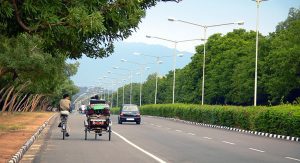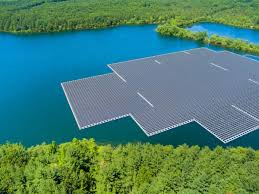Chandigarh – Chandigarh is set to take a major step toward renewable energy with the commissioning of a 4 MW floating solar power plant at Sector 39 waterworks. This initiative is part of the city’s commitment to green energy and aims to enhance renewable energy capacity while conserving water. The project underscores Chandigarh’s dedication to sustainable urban development and aligns with its larger goal of achieving self-reliance in power generation through non-conventional energy sources.


The 4 MW floating solar power plant is a significant milestone in Chandigarh’s energy landscape, marking a transition toward sustainable and eco-friendly power solutions. By installing solar panels on the water surface, the project not only generates electricity but also reduces water evaporation, making it a dual-purpose initiative that benefits both the power sector and water conservation efforts.
The Need for Renewable Energy in Chandigarh

Chandigarh has been proactively embracing renewable energy solutions to address the rising energy demands and environmental concerns. As a Union Territory, the city has limited natural resources and depends on external sources for its power supply. To overcome these limitations, the administration has been working on expanding its solar power generation capacity.
The implementation of the floating solar power plant at Sector 39 is a well-calculated decision that leverages the available water surface to generate power without occupying land. This initiative is a part of Chandigarh’s long-term vision of increasing its solar power generation capacity to 100 MW in the coming years.
Details of the 4 MW Floating Solar Power Plant
The upcoming floating solar power plant at Sector 39 waterworks is designed to generate 4 MW of electricity. This project, which is expected to cost approximately ₹24 crore, is a strategic investment that will contribute to Chandigarh’s growing green energy portfolio. The plant will generate clean electricity, reducing dependence on conventional power sources and minimizing the carbon footprint.
Floating solar power plants use photovoltaic panels installed on floating structures that are placed on the water’s surface. These installations are connected to the grid, allowing seamless integration into the city’s power supply system. The innovative design of floating solar plants ensures enhanced efficiency and durability, making them a sustainable alternative to ground-mounted solar systems.
Advantages of Floating Solar Power Plants
Floating solar power plants come with numerous advantages that make them an ideal solution for cities like Chandigarh, where land availability is a major constraint. Some key benefits include:
1. Efficient Land Use
Unlike traditional solar farms, floating solar power plants do not require vast tracts of land. By utilizing water bodies, these projects help conserve land for other urban development needs.
2. Water Conservation
Solar panels installed on water bodies help reduce evaporation, conserving valuable water resources. This is especially beneficial in regions that experience high temperatures and water shortages.
3. Higher Energy Efficiency
Water cools the solar panels, enhancing their efficiency and improving energy output. Studies indicate that floating solar panels perform better than their land-based counterparts due to the cooling effect of water.
4. Reduction in Algae Growth
By covering a portion of the water surface, floating solar panels help control excessive algae growth, improving water quality and reducing maintenance costs for water treatment plants.
5. Lower Transmission Losses
Since the solar plant at Sector 39 is located within the city, the electricity generated will be directly supplied to local consumers, reducing transmission losses that occur when power is transported over long distances.
Chandigarh’s Progress in Solar Energy
Chandigarh has made significant progress in harnessing solar energy, with multiple rooftop and floating solar power installations. The city’s renewable energy initiative has been widely recognized for its systematic and organized approach to sustainable energy adoption.
The city’s solar power generation capacity has been steadily increasing. With the addition of the 4 MW floating solar plant at Sector 39, the total installed solar capacity in Chandigarh will witness a substantial boost.
Currently, Chandigarh has implemented several solar power projects, including:
- Rooftop Solar Power Plants: Installed on government and residential buildings across the city.
- Floating Solar Plants: Several projects have already been commissioned, with more in the pipeline.
- Cycle Track Solar Power Project: A planned initiative to install solar panels along cycle tracks to generate electricity.
The Role of Chandigarh’s Renewable Energy Agency
The execution of the 4 MW floating solar power plant is being spearheaded by the city’s renewable energy agency, which has been actively promoting solar energy projects. The agency has been instrumental in developing policies, conducting feasibility studies, and ensuring the seamless execution of green energy projects.
One of the key objectives of the agency is to achieve Chandigarh’s target of 100 MW solar power generation by 2030. The city has already taken several policy measures, including making solar installations mandatory for certain categories of buildings and offering incentives for adopting renewable energy.
Technical Aspects of the Floating Solar Power Plant
The floating solar power plant at Sector 39 will feature state-of-the-art technology to ensure optimal performance and longevity. Some of the technical specifications include:
- High-Efficiency Solar Panels: The panels will be designed to withstand environmental factors while ensuring maximum energy output.
- Floating Platforms: These platforms will be made of durable and weather-resistant materials to support the solar panels on the water surface.
- Grid Connectivity: The power generated will be integrated into the existing grid system to ensure uninterrupted electricity supply.
- Advanced Monitoring Systems: Real-time data monitoring will help optimize performance and detect any issues promptly.
Future Expansion Plans


Chandigarh’s administration is exploring additional locations for solar power projects, including large parks, public spaces, and water bodies. The success of the floating solar power plant at Sector 39 will pave the way for similar projects in the future.
One of the major expansion areas under consideration is the installation of solar panels along the city’s extensive cycle tracks. The administration is conducting feasibility studies to determine the viability of this project, which, if implemented, will further boost the city’s renewable energy capacity.
Environmental Impact
The floating solar power plant is expected to have a positive impact on the environment by reducing carbon emissions and promoting clean energy. Some key environmental benefits include:
- Reduction in Greenhouse Gas Emissions: By replacing conventional electricity with solar power, the project will help reduce carbon dioxide emissions.
- Minimized Water Evaporation: As floating solar panels cover a significant portion of the water surface, they prevent excessive evaporation, ensuring water conservation.
- Improved Air Quality: Solar energy is a clean and sustainable power source that reduces the reliance on fossil fuels, contributing to better air quality in the city.
Economic Benefits
The commissioning of the 4 MW floating solar power plant is also expected to provide economic benefits to the city. Some of these include:
- Reduced Electricity Costs: With an increased supply of solar energy, consumers can expect a reduction in electricity bills over time.
- Job Creation: The project will generate employment opportunities during its construction, operation, and maintenance phases.
- Attracting Investments: Chandigarh’s commitment to renewable energy will attract investors and technology providers, further boosting economic growth.
Challenges and Solutions
While the floating solar power project offers numerous benefits, there are challenges that need to be addressed:
- Initial High Investment: The upfront cost of installing floating solar plants is higher than traditional land-based solar systems. However, the long-term savings and efficiency gains make it a viable investment.
- Maintenance and Durability: Continuous exposure to water and environmental factors can impact the longevity of solar panels. Regular maintenance and high-quality materials will help mitigate this issue.
- Integration with Existing Grid: Ensuring seamless connectivity with the city’s power grid requires robust planning and execution.
Also Read: Maharashtra-Microsoft AI Collaboration 2025: Bold Move for Smarter Governance
Closing Statements
The commissioning of the 4 MW floating solar power plant at Sector 39 is a landmark achievement for Chandigarh’s renewable energy sector. This project highlights the city’s proactive approach to sustainable development and its commitment to reducing dependence on conventional energy sources. By harnessing the power of floating solar technology, Chandigarh is setting an example for other urban centers to follow.
With ongoing advancements in solar power technology and continued government support, Chandigarh is well on its way to becoming a leader in renewable energy adoption. The successful execution of this project will serve as a blueprint for future solar initiatives, ensuring a cleaner and greener future for the city.

